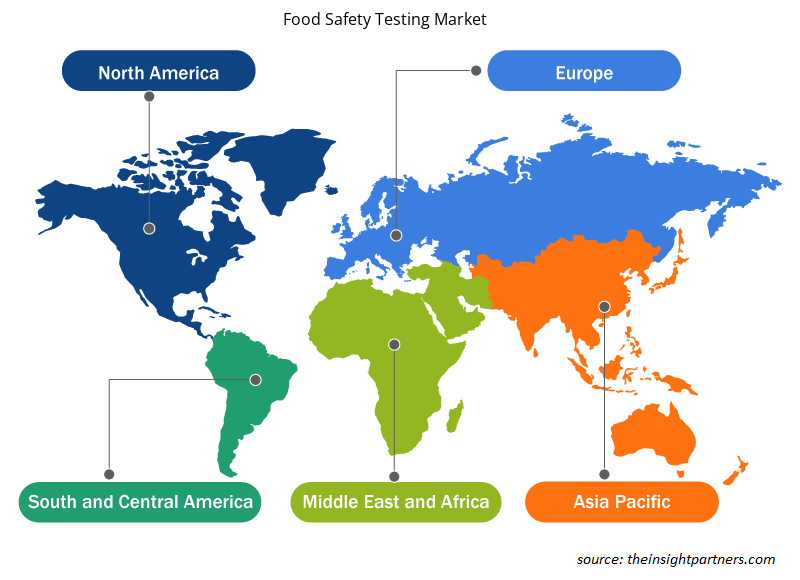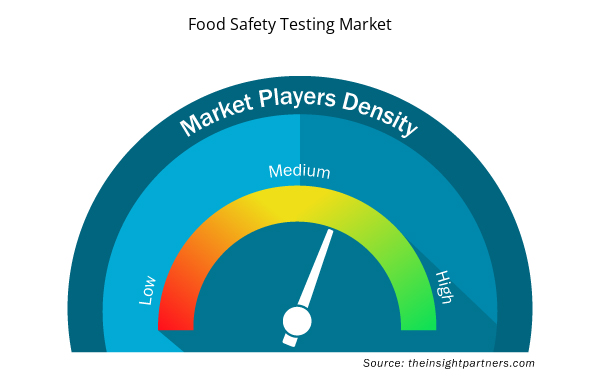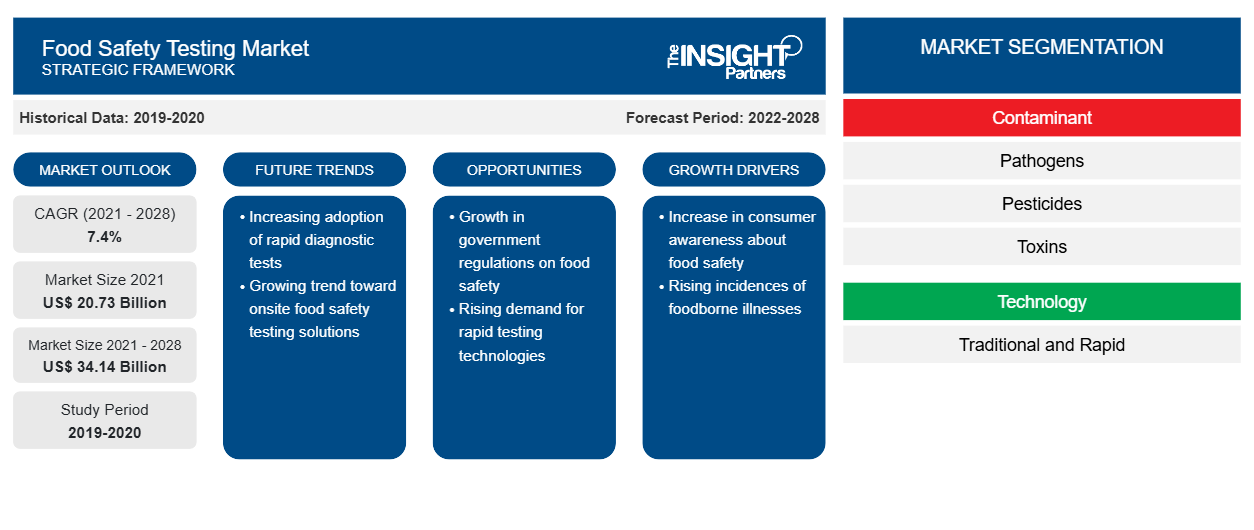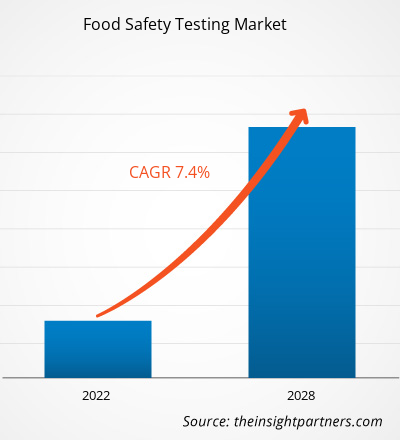Il mercato dei test sulla sicurezza alimentare è stato valutato 20.733,4 milioni di dollari nel 2021 e si prevede che raggiungerà i 34.142,5 milioni di dollari entro il 2028; si prevede una crescita a un CAGR del 7,4% dal 2021 al 2028.
I test di sicurezza alimentare sono un'analisi scientifica di un prodotto alimentare e del suo contenuto per trovare informazioni su varie caratteristiche come proprietà fisico-chimiche, composizione e struttura. Le informazioni vengono utilizzate per determinare la sicurezza del prodotto per il consumo. La crescente prevalenza di malattie trasmesse dagli alimenti richiede test di sicurezza alimentare per tutti i prodotti alimentari e delle bevande per prevenire rischi per la salute, il che aumenta la crescita del mercato dei test di sicurezza alimentare.
Secondo i dati pubblicati dall'Organizzazione mondiale della sanità (OMS), il consumo di cibo non sicuro causa 420.000 decessi e 600 milioni di casi di malattie trasmesse dagli alimenti in tutto il mondo ogni anno. Le malattie trasmesse dagli alimenti sono prevenibili; quindi, numerose organizzazioni e governi guidano azioni coordinate per costruire sistemi di sicurezza alimentare resilienti e solidi in più settori. Inoltre, un rapporto della Banca mondiale del 2018 ha stimato che l'onere economico dovuto a una perdita totale di produttività dovuta a malattie trasmesse dagli alimenti era stimato in 95,2 miliardi di dollari all'anno. Pertanto, il mercato dei test di sicurezza alimentare sta assistendo a una crescita dovuta alla consapevolezza dei consumatori in merito alla sicurezza alimentare e agli sforzi del governo per prevenire le malattie trasmesse dagli alimenti.
Personalizza questo report in base alle tue esigenze
Riceverai la personalizzazione gratuita di qualsiasi report, comprese parti di questo report, o analisi a livello nazionale, pacchetto dati Excel, oltre a usufruire di grandi offerte e sconti per start-up e università
- Scopri le principali tendenze di mercato in questo rapporto.Questo campione GRATUITO includerà analisi di dati che spaziano dalle tendenze di mercato alle stime e alle previsioni.
Impatto della pandemia di COVID-19 sul mercato dei test sulla sicurezza alimentare
La consapevolezza dei consumatori è uno dei principali motori del mercato dei test sulla sicurezza alimentare in tutto il mondo. L'epidemia di COVID-19 ha avuto un impatto positivo sul mercato poiché consumatori e governi si sono concentrati sulla sicurezza e l'igiene dei prodotti destinati al consumo. Tutti i settori alimentari e delle bevande affrontano sfide durante l'epidemia poiché il SARS-CoV-2 è altamente contagioso e potrebbe potenzialmente passare attraverso le superfici degli alimenti. Gli stabilimenti di lavorazione di carne e pollame hanno dovuto affrontare sfide particolari per quanto riguarda la trasmissione del virus poiché i lavoratori di diverse strutture in tutto il mondo sono stati infettati. Ad esempio, il Dipartimento della Salute e dei Servizi Umani degli Stati Uniti ha riferito a luglio 2020 che 239 strutture in 23 stati sono state soggette a infezione da COVID-19. Il totale dei casi segnalati è stato 16.233, con 86 decessi correlati. Inoltre, a novembre 2020, la Cina ha riferito che un campione di stinco di maiale congelato importato in Cina aveva innescato un nuovo caso di COVID-19 nel paese. Tali casi di infezioni da COVID-19 nell'industria alimentare hanno creato apprensioni tra consumatori e governi, il che ha spinto la domanda di test sulla sicurezza alimentare per mitigare i rischi per la salute.
Approfondimenti di mercato
Emergenza di focolai di malattie trasmesse dagli alimenti
Le malattie trasmesse dagli alimenti sono tossiche o infettive. Possono essere causate da sostanze chimiche, parassiti, virus che entrano nel corpo attraverso acqua o cibo contaminati. I patogeni trasmessi dagli alimenti possono causare infezioni debilitanti, come meningite o diarrea grave. In alcuni casi la contaminazione chimica può causare malattie a lungo termine, come il cancro, o malattie a breve termine, come avvelenamento acuto. Alcuni esempi di cibo non sicuro sono molluschi crudi contenenti biotossine marine, verdure e frutta contaminate da feci e cibi crudi di origine animale. Escherichia coli, campylobacter e salmonella sono tra i patogeni trasmessi dagli alimenti più comuni che colpiscono milioni di persone in tutto il mondo ogni anno e provocano esiti fatali o gravi. Alcuni sintomi delle malattie trasmesse dagli alimenti sono diarrea, dolore addominale, vomito, nausea, mal di testa e febbre. Inoltre, l'infezione da listeria porta alla morte dei neonati o ad aborti spontanei nelle donne incinte. Sebbene le probabilità di questa malattia siano relativamente basse, la mortalità della listeria la rende una delle infezioni trasmesse dagli alimenti più gravi. Il Vibrio cholera infetta le persone attraverso cibo o acqua contaminati. I suoi sintomi possono includere grave disidratazione, diarrea acquosa profusa, vomito, dolore addominale e potrebbero anche causare la morte. Vari tipi di frutti di mare, pappa di miglio, verdure e riso sono stati implicati in epidemie di colera. Pertanto, la richiesta di test sulla sicurezza alimentare è in aumento per prevenire l'incidenza di malattie trasmesse dagli alimenti.
Approfondimenti sui contaminanti
In base al contaminante, il mercato dei test sulla sicurezza alimentare è suddiviso in patogeni, pesticidi, tossine, OGM e altri. Il segmento dei patogeni ha rappresentato la quota di mercato maggiore nel 2020 e si prevede che il segmento degli OGM registrerà il CAGR più elevato nel mercato durante il periodo di previsione. I test sui patogeni vengono eseguiti per eliminare o ridurre l'incidenza delle malattie trasmesse dagli alimenti. L'eliminazione è considerata così essenziale che il processo di test viene implementato nella fase stessa della produzione alimentare per garantire la sicurezza e l'igiene alimentare. Alcuni dei patogeni più comuni che possono causare malattie trasmesse dagli alimenti sono E. coli, listeria e salmonella. I test sui patogeni possono essere eseguiti utilizzando tecniche tradizionali o più recenti. Le tecniche tradizionali utilizzano standard di coltura cellulare convenzionali, mentre le tecniche più recenti includono diagnosi basate su laser o spettrometria. Poiché i patogeni sono una delle cause più comuni delle malattie trasmesse dagli alimenti, il segmento dei patogeni detiene la quota di mercato maggiore nel mercato dei test sulla sicurezza alimentare. Inoltre, si prevede che il mercato per questo segmento crescerà durante il periodo di previsione a causa della crescita del settore alimentare e delle bevande.
Approfondimenti tecnologici
In base alla tecnologia, il mercato dei test di sicurezza alimentare è diviso in tradizionale e rapido. Il segmento rapido ha rappresentato una quota di mercato maggiore nel 2020 e si prevede che lo stesso segmento registrerà un CAGR più elevato nel mercato durante il periodo di previsione. I principali attori del mercato stanno introducendo prodotti innovativi nei test rapidi a causa dell'elevata domanda del servizio. Ad esempio, nel 2009, bioMérieux, Inc. ha introdotto TEMPO, un sistema automatizzato per l'enumerazione dei microrganismi negli alimenti. Il sistema automatizzato elimina i noiosi passaggi manuali coinvolti nel metodo del numero più probabile (MPN) utilizzando una scheda in miniatura. Pertanto, il test automatizzato offre una semplice tracciabilità e un'elevata produttività ed è anche un'alternativa conveniente ai test manuali. Inoltre, l'azienda ha anche introdotto la tecnologia dei batteriofagi ricombinanti utilizzata per il rilevamento di patogeni trasmessi dagli alimenti, che ha ridotto il tempo di crescita dei batteri a un livello rilevabile. Tali test rapidi si dimostrano utili in termini di risparmio sui costi per i produttori di alimenti poiché il periodo di attesa per i lotti in inventario è notevolmente ridotto. Si prevede quindi che i molteplici vantaggi dei test rapidi alimenteranno la crescita del mercato per questo segmento durante il periodo di previsione.
Informazioni sul tipo di cibo
In base al tipo di alimento, il mercato dei test di sicurezza alimentare è suddiviso in prodotti a base di carne, pollame e frutti di mare; latticini; cereali e granaglie; alimenti trasformati; frutta e verdura; e altri. Il segmento dei prodotti a base di carne, pollame e frutti di mare ha rappresentato la quota di mercato maggiore nel 2020 e si prevede che il segmento di frutta e verdura registrerà il CAGR più elevato nel mercato durante il periodo di previsione. I test sui prodotti a base di carne, pollame e frutti di mare includono test per contaminanti e per adulterazione alimentare in cui un tipo di carne viene adulterato con altri tipi di carne. I prodotti possono essere testati per ceneri, grassi, umidità, proteine/azoto, metalli pesanti, pesticidi, antibiotici e farmaci, sale, cloruro e nitrati e nitriti. I prodotti a base di carne hanno maggiori probabilità di essere contaminati o difettosi considerando la durata di conservazione e la natura di questi prodotti. Pertanto, i test per questi prodotti sono obbligatori in tutti i paesi. Si prevede che il mercato per questo segmento crescerà a causa del crescente consumo di prodotti a base di carne, pollame e frutti di mare in tutto il mondo.
Alcuni attori che operano nel mercato dei test sulla sicurezza alimentare sono SGS SA, Eurofins Scientific, Intertek Group Plc, TÜV SÜD, AES Laboratories Pvt. Ltd., TÜV NORD GROUP., Bureau Veritas, ALS Limited, NEOGEN Corporation e AsureQuality. Queste aziende forniscono un'ampia gamma di portafogli di prodotti per il mercato. Le aziende sono presenti nelle regioni in via di sviluppo, il che offre opportunità redditizie per la crescita del mercato dei test sulla sicurezza alimentare. Gli attori del mercato stanno sviluppando prodotti innovativi e di alta qualità per soddisfare i requisiti del cliente.
Segnala i riflettori
- Tendenze industriali progressive nel mercato dei test sulla sicurezza alimentare per aiutare gli operatori a sviluppare strategie efficaci a lungo termine
- Strategie di crescita aziendale adottate dai mercati sviluppati e in via di sviluppo
- Analisi quantitativa del mercato dei test sulla sicurezza alimentare dal 2019 al 2028
- Stima della domanda globale di test sulla sicurezza alimentare
- Analisi delle cinque forze di Porter per illustrare l'efficacia degli acquirenti e dei fornitori che operano nel settore
- Sviluppi recenti per comprendere lo scenario competitivo del mercato
- Tendenze e prospettive del mercato, nonché fattori che guidano e frenano la crescita del mercato dei test sulla sicurezza alimentare
- Assistenza nel processo decisionale evidenziando le strategie di mercato che sostengono l'interesse commerciale, portando alla crescita del mercato
- La dimensione del mercato dei test sulla sicurezza alimentare in vari nodi
- Panoramica dettagliata e segmentazione del mercato, nonché dinamiche del settore dei test sulla sicurezza alimentare
- Dimensioni del mercato dei test sulla sicurezza alimentare in varie regioni con promettenti opportunità di crescita
Approfondimenti regionali sul mercato dei test sulla sicurezza alimentare
Le tendenze regionali e i fattori che influenzano il Food Safety Testing Market durante il periodo di previsione sono stati ampiamente spiegati dagli analisti di Insight Partners. Questa sezione discute anche i segmenti e la geografia del Food Safety Testing Market in Nord America, Europa, Asia Pacifico, Medio Oriente e Africa e Sud e Centro America.

- Ottieni i dati specifici regionali per il mercato dei test sulla sicurezza alimentare
Ambito del rapporto di mercato sui test di sicurezza alimentare
| Attributo del report | Dettagli |
|---|---|
| Dimensioni del mercato nel 2021 | 20,73 miliardi di dollari USA |
| Dimensioni del mercato entro il 2028 | 34,14 miliardi di dollari USA |
| CAGR globale (2021 - 2028) | 7,4% |
| Dati storici | 2019-2020 |
| Periodo di previsione | 2022-2028 |
| Segmenti coperti | Per contaminante
|
| Regioni e Paesi coperti | America del Nord
|
| Leader di mercato e profili aziendali chiave |
|
Densità degli attori del mercato dei test sulla sicurezza alimentare: comprendere il suo impatto sulle dinamiche aziendali
Il mercato dei test sulla sicurezza alimentare sta crescendo rapidamente, spinto dalla crescente domanda degli utenti finali dovuta a fattori quali l'evoluzione delle preferenze dei consumatori, i progressi tecnologici e una maggiore consapevolezza dei benefici del prodotto. Con l'aumento della domanda, le aziende stanno ampliando le loro offerte, innovando per soddisfare le esigenze dei consumatori e capitalizzando sulle tendenze emergenti, il che alimenta ulteriormente la crescita del mercato.
La densità degli operatori di mercato si riferisce alla distribuzione di aziende o società che operano in un particolare mercato o settore. Indica quanti concorrenti (operatori di mercato) sono presenti in un dato spazio di mercato in relazione alle sue dimensioni o al valore di mercato totale.
Le principali aziende che operano nel mercato dei test sulla sicurezza alimentare sono:
- SGS SA
- Eurofins Scientific
- GRUPPO INTERTEK PLC
- TÜV SUD
- Azienda: AES Laboratories Pvt. Ltd.
Disclaimer : le aziende elencate sopra non sono classificate secondo un ordine particolare.

- Ottieni una panoramica dei principali attori del mercato dei test sulla sicurezza alimentare
Mercato dei test sulla sicurezza alimentare – per contaminante
- Patogeni
- Salmonella
- Escherichia coli
- Listeria
- Altri
- Pesticidi
- Tossine
- OGM
- Altri
Mercato dei test sulla sicurezza alimentare – per tecnologia
- Tradizionale
- Rapid
- Test basati su PCR
- Test basati su immunoanalisi
- Altri
Mercato dei test sulla sicurezza alimentare – per tipo di alimento
- Prodotti a base di carne, pollame e pesce
- Prodotti lattiero-caseari
- Cereali e granaglie
- Cibo lavorato
- Frutta e verdura
- Altri
Profili aziendali
- SGS SA
- Eurofins Scientific
- Gruppo Intertek Plc
- TÜV SUD
- Azienda: AES Laboratories Pvt. Ltd.
- GRUPPO TÜV NORD.
- Ufficio Veritas
- ALS limitata
- Società NEOGEN
- AsureQuality
- Analisi storica (2 anni), anno base, previsione (7 anni) con CAGR
- Analisi PEST e SWOT
- Valore/volume delle dimensioni del mercato - Globale, regionale, nazionale
- Industria e panorama competitivo
- Set di dati Excel



Report Coverage
Revenue forecast, Company Analysis, Industry landscape, Growth factors, and Trends

Segment Covered
This text is related
to segments covered.

Regional Scope
North America, Europe, Asia Pacific, Middle East & Africa, South & Central America

Country Scope
This text is related
to country scope.
Domande frequenti
Based on technology, the food safety testing market is bifurcated into traditional and rapid. The rapid segment accounted for a larger market share in 2020. Rapid tests prove to be useful in terms of cost saving for food manufacturers as the waiting period for batches in inventory is significantly reduced. Thus, the multiple benefits of rapid testing is expected to fuel the market growth for this segment during the forecast period.
In 2020, China held the largest market share in the global food safety testing market. China is the most populated country in the world and is a major hub for food and beverages industry. The country annually imports and exports large quantities of food products to different parts of the world. As per data published by the International Trade Administration, U.S. Department of Commerce, the food and beverage sector of China reached US$ 595 billion in 2019 in terms of consumption. Moreover, considering the aggressive development of China and rising middle class population with high disposable income, numerous food brands are attempting to enter the market in the country. Therefore, the food trade as well as consumption in the country is growing at a high pace resulting in positive impact for food safety testing, as testing in the country is becoming increasingly stringent for food processing.
The pathogens segment accounted for the largest market share in 2020. Since pathogens are one of the most common reasons for foodborne illnesses, the pathogen segment holds the largest market share in the food safety testing market. Also, the market for this segment is expected to grow at a high pace during the forecast period due to the growth of the food & beverages industry.
The major players operating in the global food safety testing market are SGS SA, Eurofins Scientific, Intertek Group Plc, TÃœV SÃœD, AES Laboratories Pvt. Ltd., TÃœV NORD GROUP., Bureau Veritas, ALS Limited, NEOGEN Corporation, and AsureQuality.
Foodborne illnesses are toxic or infectious. They can be caused by the chemical substances, parasites, viruses entering the body through contaminated water or food. In some cases chemical contamination can cause long-term diseases, such as cancer, or short-term illness, such as acute poisoning. A few examples of unsafe food are raw shellfish containing marine biotoxins, vegetables and fruits contaminated with feces, and uncooked foods of animal origin. E. Coli, campylobacter, and salmonella are among the most common foodborne pathogens that affect millions of people worldwide annually and result in fatal or severe outcomes. Moreover, listeria infection leads to death of newborn babies or miscarriages in pregnant women. Although the chances of this disease are relatively low, the fatality of listeria makes it one of the most serious foodborne infections. Vibrio cholera infects people through contaminated food or water. Various types of seafood, millet gruel, vegetables, and rice have been implicated in cholera outbreaks. Therefore, the demand for food safety testing is increasing to prevent the incidence of foodborne illnesses.
In 2020, North America held the largest share of the market. The Centre for Disease Control and Prevention (CDC) has determined that one out of ten people fall sick due to foodborne illness each year in the US. The rising incidence of foodborne diseases has propelled the need for rapid testing, which is driving the market growth in North America. Additionally, enhanced detection and surveillance methods have fueled the food safety testing market growth in North America.
Trends and growth analysis reports related to Consumer Goods : READ MORE..
The List of Companies - Food Safety Testing Market
- SGS SA
- Eurofins Scientific
- INTERTEK GROUP PLC
- TÜV SÜD
- AES Laboratories Pvt. Ltd.
- TÜV NORD GROUP.
- BUREAU VERITAS
- ALS Limited
- NEOGEN Corporation
- AsureQuality
The Insight Partners performs research in 4 major stages: Data Collection & Secondary Research, Primary Research, Data Analysis and Data Triangulation & Final Review.
- Data Collection and Secondary Research:
As a market research and consulting firm operating from a decade, we have published and advised several client across the globe. First step for any study will start with an assessment of currently available data and insights from existing reports. Further, historical and current market information is collected from Investor Presentations, Annual Reports, SEC Filings, etc., and other information related to company’s performance and market positioning are gathered from Paid Databases (Factiva, Hoovers, and Reuters) and various other publications available in public domain.
Several associations trade associates, technical forums, institutes, societies and organization are accessed to gain technical as well as market related insights through their publications such as research papers, blogs and press releases related to the studies are referred to get cues about the market. Further, white papers, journals, magazines, and other news articles published in last 3 years are scrutinized and analyzed to understand the current market trends.
- Primary Research:
The primarily interview analysis comprise of data obtained from industry participants interview and answers to survey questions gathered by in-house primary team.
For primary research, interviews are conducted with industry experts/CEOs/Marketing Managers/VPs/Subject Matter Experts from both demand and supply side to get a 360-degree view of the market. The primary team conducts several interviews based on the complexity of the markets to understand the various market trends and dynamics which makes research more credible and precise.
A typical research interview fulfils the following functions:
- Provides first-hand information on the market size, market trends, growth trends, competitive landscape, and outlook
- Validates and strengthens in-house secondary research findings
- Develops the analysis team’s expertise and market understanding
Primary research involves email interactions and telephone interviews for each market, category, segment, and sub-segment across geographies. The participants who typically take part in such a process include, but are not limited to:
- Industry participants: VPs, business development managers, market intelligence managers and national sales managers
- Outside experts: Valuation experts, research analysts and key opinion leaders specializing in the electronics and semiconductor industry.
Below is the breakup of our primary respondents by company, designation, and region:

Once we receive the confirmation from primary research sources or primary respondents, we finalize the base year market estimation and forecast the data as per the macroeconomic and microeconomic factors assessed during data collection.
- Data Analysis:
Once data is validated through both secondary as well as primary respondents, we finalize the market estimations by hypothesis formulation and factor analysis at regional and country level.
- Macro-Economic Factor Analysis:
We analyse macroeconomic indicators such the gross domestic product (GDP), increase in the demand for goods and services across industries, technological advancement, regional economic growth, governmental policies, the influence of COVID-19, PEST analysis, and other aspects. This analysis aids in setting benchmarks for various nations/regions and approximating market splits. Additionally, the general trend of the aforementioned components aid in determining the market's development possibilities.
- Country Level Data:
Various factors that are especially aligned to the country are taken into account to determine the market size for a certain area and country, including the presence of vendors, such as headquarters and offices, the country's GDP, demand patterns, and industry growth. To comprehend the market dynamics for the nation, a number of growth variables, inhibitors, application areas, and current market trends are researched. The aforementioned elements aid in determining the country's overall market's growth potential.
- Company Profile:
The “Table of Contents” is formulated by listing and analyzing more than 25 - 30 companies operating in the market ecosystem across geographies. However, we profile only 10 companies as a standard practice in our syndicate reports. These 10 companies comprise leading, emerging, and regional players. Nonetheless, our analysis is not restricted to the 10 listed companies, we also analyze other companies present in the market to develop a holistic view and understand the prevailing trends. The “Company Profiles” section in the report covers key facts, business description, products & services, financial information, SWOT analysis, and key developments. The financial information presented is extracted from the annual reports and official documents of the publicly listed companies. Upon collecting the information for the sections of respective companies, we verify them via various primary sources and then compile the data in respective company profiles. The company level information helps us in deriving the base number as well as in forecasting the market size.
- Developing Base Number:
Aggregation of sales statistics (2020-2022) and macro-economic factor, and other secondary and primary research insights are utilized to arrive at base number and related market shares for 2022. The data gaps are identified in this step and relevant market data is analyzed, collected from paid primary interviews or databases. On finalizing the base year market size, forecasts are developed on the basis of macro-economic, industry and market growth factors and company level analysis.
- Data Triangulation and Final Review:
The market findings and base year market size calculations are validated from supply as well as demand side. Demand side validations are based on macro-economic factor analysis and benchmarks for respective regions and countries. In case of supply side validations, revenues of major companies are estimated (in case not available) based on industry benchmark, approximate number of employees, product portfolio, and primary interviews revenues are gathered. Further revenue from target product/service segment is assessed to avoid overshooting of market statistics. In case of heavy deviations between supply and demand side values, all thes steps are repeated to achieve synchronization.
We follow an iterative model, wherein we share our research findings with Subject Matter Experts (SME’s) and Key Opinion Leaders (KOLs) until consensus view of the market is not formulated – this model negates any drastic deviation in the opinions of experts. Only validated and universally acceptable research findings are quoted in our reports.
We have important check points that we use to validate our research findings – which we call – data triangulation, where we validate the information, we generate from secondary sources with primary interviews and then we re-validate with our internal data bases and Subject matter experts. This comprehensive model enables us to deliver high quality, reliable data in shortest possible time.


 Ottieni un campione gratuito per questo repot
Ottieni un campione gratuito per questo repot